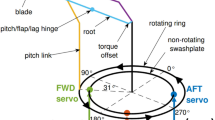Abstract
The purpose of using life extending control for Black Hawk UH-60 helicopter is to make a trade-off between the handling qualities and the service life of critical components. An increase in service life span results in enhanced safety and the reduction in maintenance costs. This paper presents a design methodology of life extending control for structural durability and high performance of mechanical system, which is based on an explicit dynamic inversion control scheme. A real-time nonlinear fatigue crack growth model is built to predict fatigue damage resulting from the impact of cyclic bending stress on rotor shaft, which serves as an indicator of service life. The 4-axis gain-scheduled flight controller, whose gains are adjusted as a function of damage and flight velocity, is designed to regulate roll attitude, pitch attitude, vertical velocity and yaw rate. The nonlinear system simulation results show that the responses can meet the requirements on ADS-33 Level 1 handling qualities and that the 4-axis decoupling control is realized. As the damage increases, the tracking performance is slightly degraded, which results in smaller transients in bending moment response.
Similar content being viewed by others
References
Lorenzo C F, Merrill W C. An intelligent control system for rocket engines: Need, vision, and issues[J]. IEEE Control Systems, 1991, 11(1): 42–46.
Chowdhary G, Johnson E N, Chandramohan R et al. Guidance and control of airplanes under actuator failures and severe structural damage[J]. AIAA Journal of Guidance Control and Dynamics, 2013, 36(4): 1093–1104.
Matsuzaki Y, Ueda T, Miyazawa Y et al. Gust load alleviation of a transport-type wing: Test and analysis[J]. AIAA Journal of Aircraft, 1989, 26(4): 322–327.
Ray A, Wu M K, Carpino M et al. Damage-mitigating control of mechanical systems: Part I-Conceptual development and model formulation[J]. ASME Journal of Dynamic Systems, Measurements, and Control, 1994, 116(3): 437–447.
Sieberling S, Chu Q P, Mulder J A. Robust flight control using incremental nonlinear dynamic inversion and angular acceleration prediction [J]. Journal of Guidance, Control, and Dynamics, 2010, 33(6): 1732–1742.
Bajodah A H. Generalised dynamic inversion spacecraft control design methodologies[J]. IET Control Theory and Applications, 2009, 3(2): 239–251.
Lorenzo C F, Merrill W C. Life extending control: A concept paper[C]. In: American Control Conference. Boston, USA, 1991.
Ashokkumar C R, Dattaguru B, Iyengar N G R. Adaptive control for structural damage mitigation[J]. Global Journal of Researches in Engineering-D: Aerospace Engineering, 2011, 11(5): 13–19.
Brian L S, Frank L L. Aircraft Control and Simulation[M]. John Wiley, USA, 2003.
Guo W, Horn J F. Rotor state feedback control for rotorcraft with variable rotor speed[C]. In: AIAA Guidance, Navigation, and Control Conference. Chicago, USA, 2009.
Horn J F, Guo W, Ozdemir G T. Use of rotor state feedback to improve closed loop stability and handling qualities[J]. Journal of the American Helicopter Society, 2012, 57(2): 1–10.
Patankar R, Ray A. State-space modeling of fatigue crack growth in ductile alloys[J]. Engineering Fracture Mechanics, 2000, 66(2): 129–151.
Singh D S, Gupta S, Ray A. Symbolic dynamic analysis of surface deformation during fatigue crack initiation[J]. Measurement Science and Technology, 2010, 21(4): 043003.
Newman Jr J C. A cracking opening stress equation for fatigue crack growth[J]. International Journal of Fracture, 1984, 24(4): 131–135.
Patankar R, Ray A. Damage mitigating controller design for structural durability[J]. IEEE Transactions on Control Systems Technology, 1999, 7(5): 606–612.
Author information
Authors and Affiliations
Corresponding author
Additional information
Supported by the National Natural Science Foundation of China (No. 61170328).
Liu Jing, born in 1987, female, doctorate student.
Rights and permissions
About this article
Cite this article
Liu, J., Wu, A. Life extending control of helicopter based on dynamic inversion. Trans. Tianjin Univ. 20, 215–222 (2014). https://doi.org/10.1007/s12209-014-2198-6
Accepted:
Published:
Issue Date:
DOI: https://doi.org/10.1007/s12209-014-2198-6




